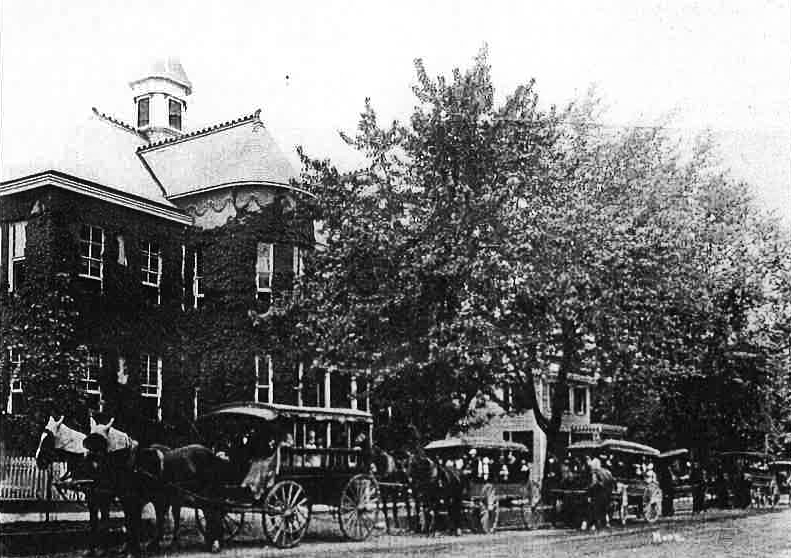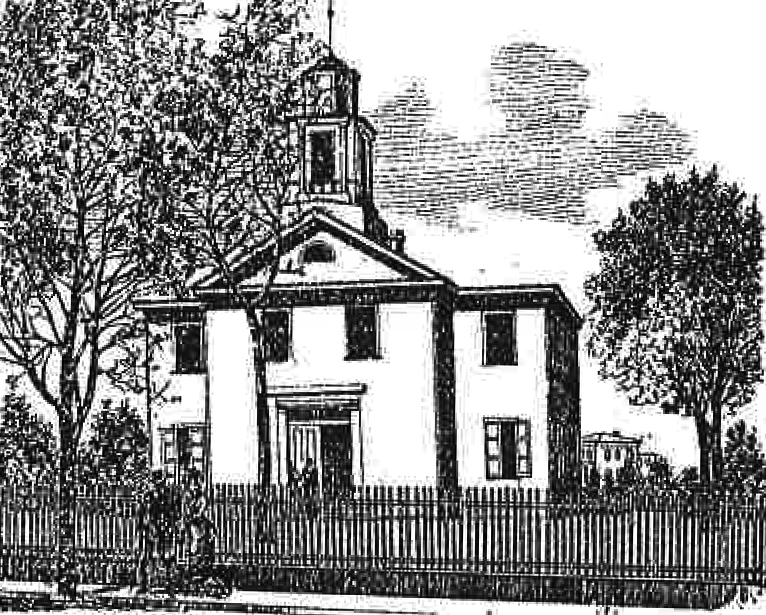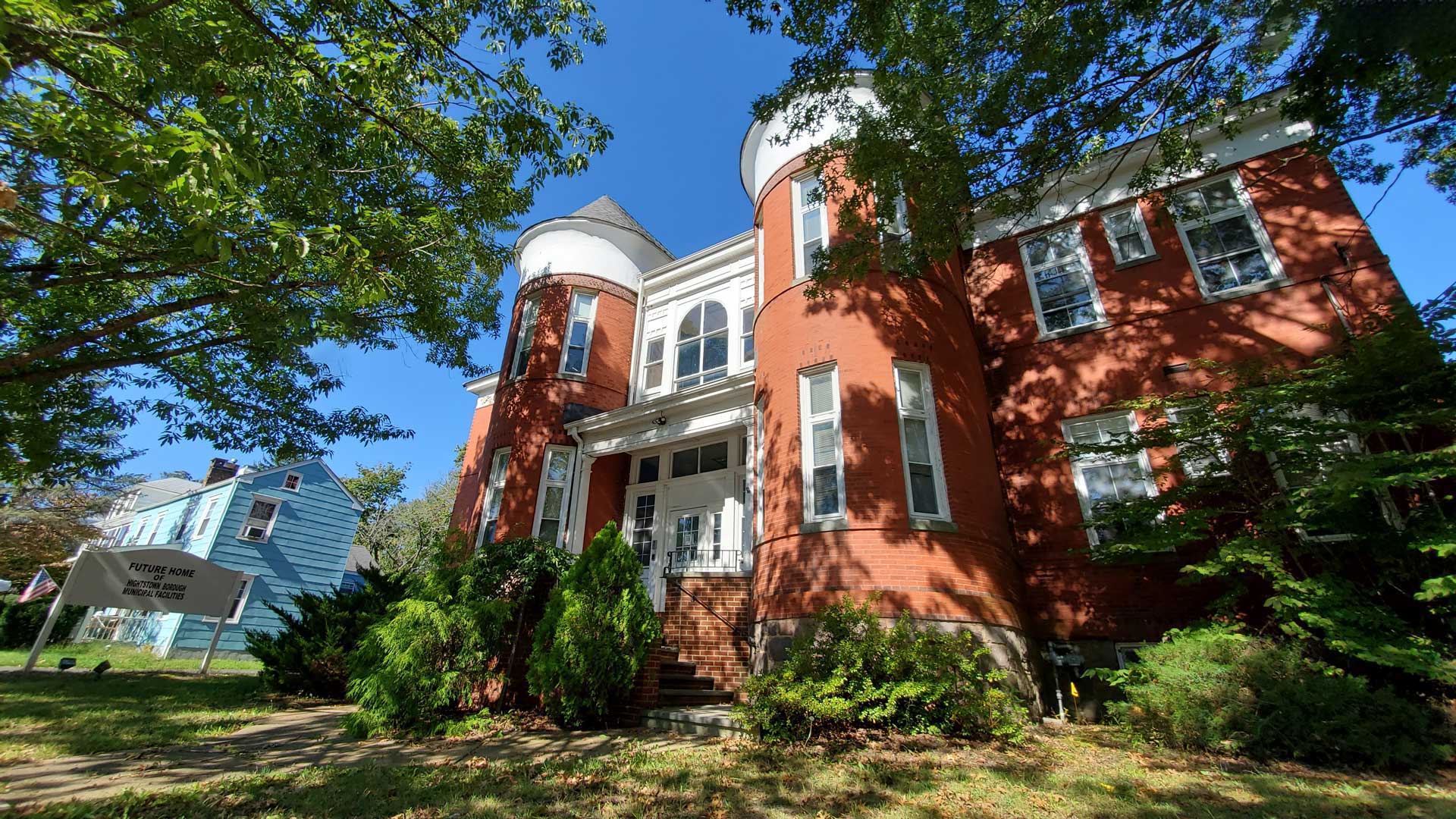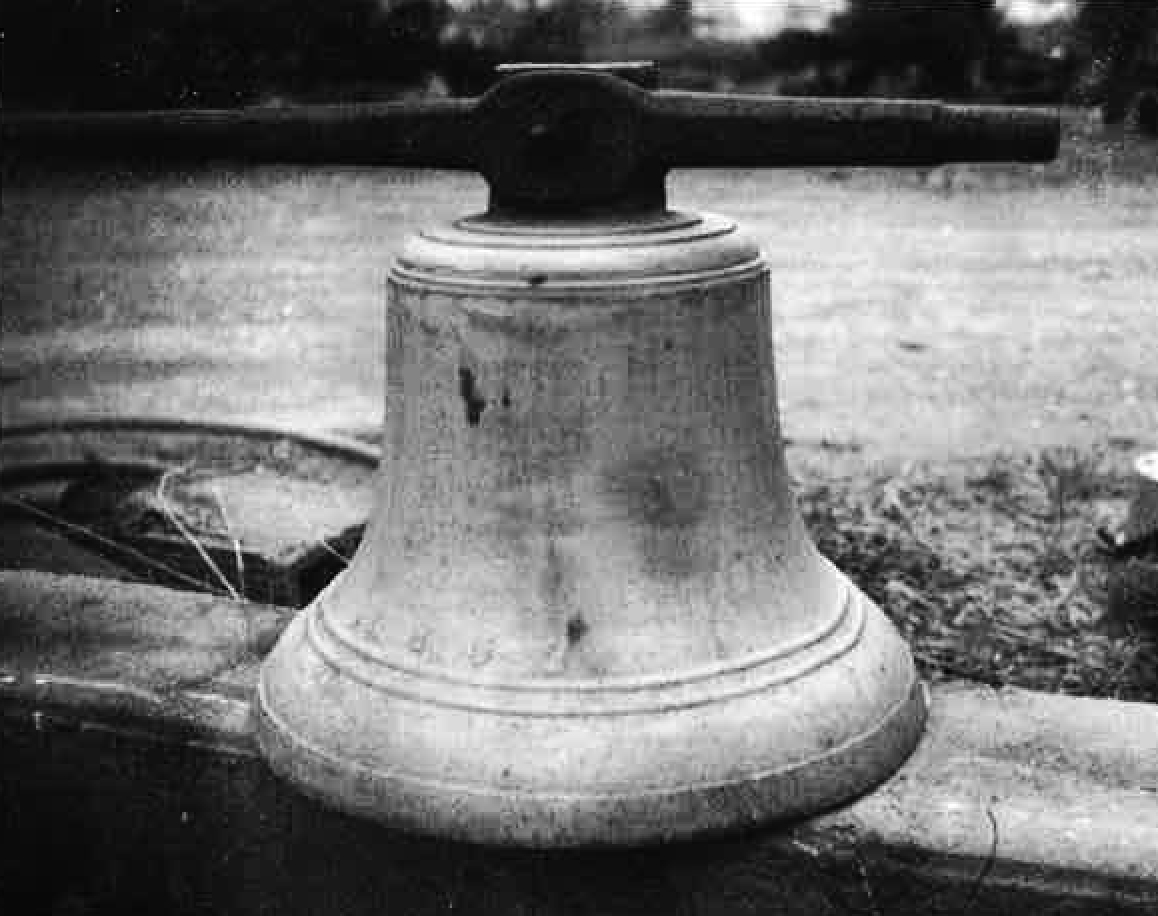

The Early Years
In the early and mid-19th century, the area had several one-room schoolhouses like the Etra School House seen in this picture.
There were also fee schools located in houses as well as buildings built by the various church congregations. In 1864 the Presbyterian Church built Van Rensaller Institute on the east side of North Main Street (a four-story building long gone but the name of the dead-end street remains). The Baptist Church started a school on Main Street for girls in 1863 but it changed to co-educational the following year and renamed it “The New Jersey Classical and Scientific Institute”, the forerunner of Peddie School.

The Academy
But the Academy was the first real “public school” and was built in 1841 on Mercer Street. The land was donated by John C. Ward who would later also sell and donate the ground for the current Peddie School. Mr. Ward owned most of the south side of the current Hightstown, thus East and West Ward Streets. The Academy building was two stories but with only one room per floor. Students educated there had family names of Allen, Applegate, Ashton, Conover, Early, Eldridge, Ely Ford, Groves, McMichael, Ogborn, Pullen, Shangle, Smith, Smock, Tindall, and Wood. Also, Elwood Silvers, this writer’s great-great grand uncle, who was killed in Virginia in the Civil War.
In the Village Record, September 10, 1858, an unnamed student wrote a description of the Academy. Excerpts are as follows: “The Academy is situated about three hundred yards from the prosperous borough of Hightstown. It is on a hill, surrounded on the north and east by the village, and on the south and west by a few scattered dwellings and the works of nature. The building is about twenty-five feet from the fence in front, and is two stories high, adorned with a steeple containing a bell whose tinkling sound calls the youth to school.” …. “The external appearance far surpasses the internal. On entering the room of the higher department, to which I shall confine myself, my eyes are attracted to the walls; on the left I see maps of the Southern and Eastern States, and on the right a map of Asia, drawn by one who does not understand his profession.” More description of the room is, “There are two closets in the room, above the left hand one stands a clock, and a cigar box (a receptacle for the pen, ink, and trinkets of some absent school boy).” He did not have good things to write about the furniture.
Two additional rooms were added in 1859. The April 19, 1866, Hightstown Gazette reported that there was to be a meeting in the Academy to consider how to raise money for the needed repairs to the building. The article listed many issues, both interior and exterior, including “The roof is in a leaky condition, and with every N.E. storm the inside walls of one end of the building are drenched with water, damaging blackboards and ceilings.” The article ended by stating that the total taxable property in the school district was now about $450,000 and ten cents on every hundred will produce $450 for the needed repairs.
In 1884, 13 years after the State Legislature established free nine-month school for all children, a larger addition was added to handle the extra students. Before the Legislation and a Constitutional change in 1875, the schools were “partial pay.” Some Village Record and Hightstown Gazette articles reflect a high percentage of absenteeism, but education was a priority for the Hightstown-East Windsor citizens. Young boys, in particular, had work duties to perform for the family, thus the absenteeism at times.

Mercer Street School
The student population increased to the point that in 1894 the Board of Education approved the building of a large, two-story brick building and as a result, the Academy was razed. Academy Street is the remaining reminder of this school. The large bell in the Academy was moved from its tower to the new belfry in the large, brick Mercer Street School. The property for this building extends from Mercer Street back to the Greenway, Railroad Avenue, and Dawes Park.
A description of the building as reported in the January 3, 1895, Hightstown Gazette, headline, “Our New Public School”:
“It is putting it very mildly to say that general satisfaction with the results was expressed and that our tax payers are delighted with the efforts of the board of education, the architect, the contractor and all others who have helped to bring the building to completion.”
There were tours and speeches reported but I’ll skip to the descriptions. “The building is a handsome brick structure, with stone trimmings and a slate roof. It has a frontage of 72 ½ ft and is 50 ft deep, with a rear projection of 10 ft. 8 in. by 36 ft. There are eight large rooms 27 by 23 ft. with 12 ft ceilings and each connected with separate cloakroom. The two round projections in the front contain two small rooms each, which will be used for a principal’s office, etc. Each school-room is admirably lighted and provided with simple means of ventilation. Steam heat is used. The entire interior is made up of light oiled wood and rough finished walls, which give the rooms a decidedly cheerful look. Each room is provided with abundant black-boards. On August 14th the sum of $12,000 was appropriated by the district for this purpose. G.K. Parsell, of New Brunswick, was the architect for the building and the contract was awarded to Daniel Whitlock, of New Brunswick, for $10,245. Mr. Whitlock and his men did the carpenter work and the mason work was done by William H. Dillon and others. L.W. Grover furnished all of the mill work and C. H. Pembrook has attended to the painting. The heating apparatus was put in by Shangle & Son. In spite of the fact that Architect Parsell’s original plans were somewhat altered for sake of economy and a considerable amount of decoration was sacrificed, the building is one of which he may be proud. It is an ornament to the town and our citizens are to be congratulated on its appearance. As for the most important part, the interior, it is all that can be desired. Wide stairs, ample halls, large cloak-rooms and bright, healthful and spacious school-rooms will make school-going a pleasure to the young folks. Hightstown has every reason to congratulate itself on its new Public School.”
This writer recalls the back entrance to the building had two doors on opposite sides of the stairwell. Over one door was a sign “BOYS” and over the other “GIRLS”. They used separate entrances!
From the time it opened, it operated as the first eight grades of public school until 1913, when the upper grades moved to the Stockton Street School (that school no longer exists – it was in front of the Walter C. Black School facing Stockton Street).
The last classes were held in the Mercer Street School in 1939. I was always told it was because the State Board of Education had condemned it. It would have been very costly to modernize to 1940s requirements, so the Board of Education put the building up for public bid in 1941.
Local lore has it that only two parties were bidding on Saturday, September 6, 1941, at 2 pm. The Free & Accepted Masons and the Hightstown House Wrecking Company. The winning bid was $2,265 after the Wrecking Company pulled out of the process. The story goes that they only wanted it for its brick but when they found out that the other bidding gentlemen were Masons who were going to use it as a Temple, they withdrew from bidding any higher as they too were Masons in another town.

New Life for The Bell
I was recently contacted by Mike Mendenko of Village Nurseries about a bell in his possession. He was not sure of its origin and some thought that it might have been from the Clara Barton School at Cedar Swamp. However, my research of past published materials confirms that it was forged or cast in New York in 1852 and it is indeed the Academy bell. In the Village Record from August 11, 1853, there appears the obituary of a Peter Bilyeu. The obituary states that his life was “one of active usefulness and benevolence and up to the time of his last illness was more active than most of men many years younger than himself (77).” It continues, “His last act of public benefit was procuring a bell for the Academy in this village, and after his body had been lowered into the grave, this bell commenced tolling, forcibly reminding us that though ‘dead he yet speaketh.'” Mr. Bilyeu was born in 1776. Coincidentally, in 1852, the date on the bell, the village residents voted to incorporate the Borough of Hightstown. The NJ Legislature approved the same in 1853.
Other articles refer to the purchase of the bell which all but makes it certain that this is the same bell. Village Record, December 17, 1852, “Notice – The undersigned takes this method of returning sincere thanks to Peter Bylieu, Senior, Esq., in behalf of the Trustees of School District No. 1, for his untiring exertions in securing a Bell, for the use of the Academy. John Butcher, Trustee”.
Walter C. Black, the prior owner of the Village Nurseries, was active on the school board and was also in the Masons when the Mercer Street School was purchased by the Lodge in 1941. It is logical that he may have moved it to the nursery when the belfry was removed from the Mercer Street School for safekeeping for future use. Gratefully the bell was not sold or discarded.
Our family has purchased the bell and will be donating it to the Society with the condition that it be “on loan” to the Borough and placed in a prominent location inside the “new” borough hall for all to see and enjoy. It will thus be returned to its original site and placed inside of its second home, rather than on the roof and out of sight.
It will be nice to see this building put to much more public use, and for the old bell to be put on display. Thank you, Mr. Bilyeu.
Support local history like this by becoming a member here.
